The Ultimate Facebook Marketing Guide
Why Facebook?
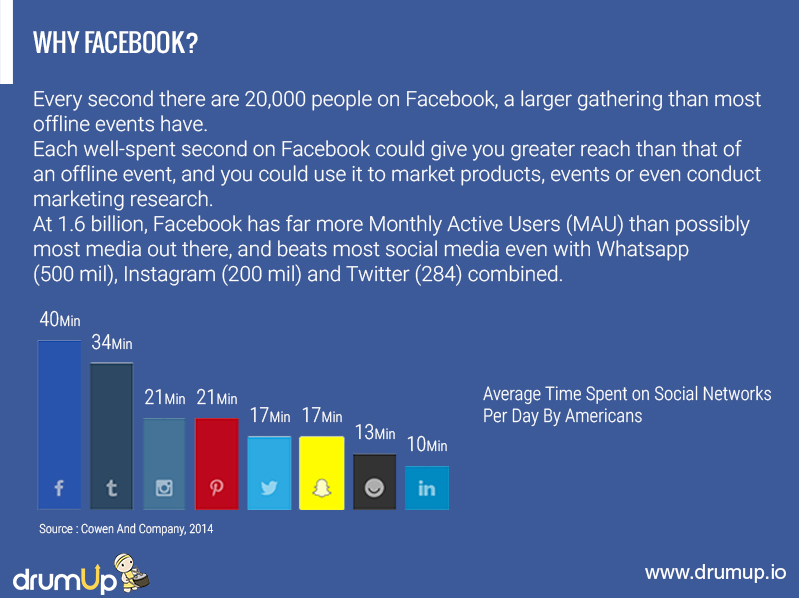
Every second there are 20,000 people on Facebook, a larger gathering than most offline events have.
Each well-spent second on Facebook could give you greater reach than that of an offline event, and you could use it to market products, events or even conduct marketing research.
At 1.6 billion, Facebook has far more Monthly Active Users (MAU) than possibly most media out there, and beats most social media even with Whatsapp (500 mil), Instagram (200 mil) and Twitter (284) combined.
Whether you’re a B2C business or B2B, Facebook is a useful social media site to market on.
Facebook marketing lets you
1) Continue engaging with your audience beyond their first purchase (and in turn nurture potential re-orders)
2) Develop and maintain an affable brand identity and a trustworthy brand reputation (essential in earning credibility as a business)
3) Build a fan following of your target market (so you can keep them updated on the latest products, services and offers)
4) Grow your sales numbers over time (Facebook is an excellent platform for lead nurturing)
5) Support your Search Engine Optimization efforts (by link-building to your website pages and blogs)
Tips to Create Compelling Posts for Facebook
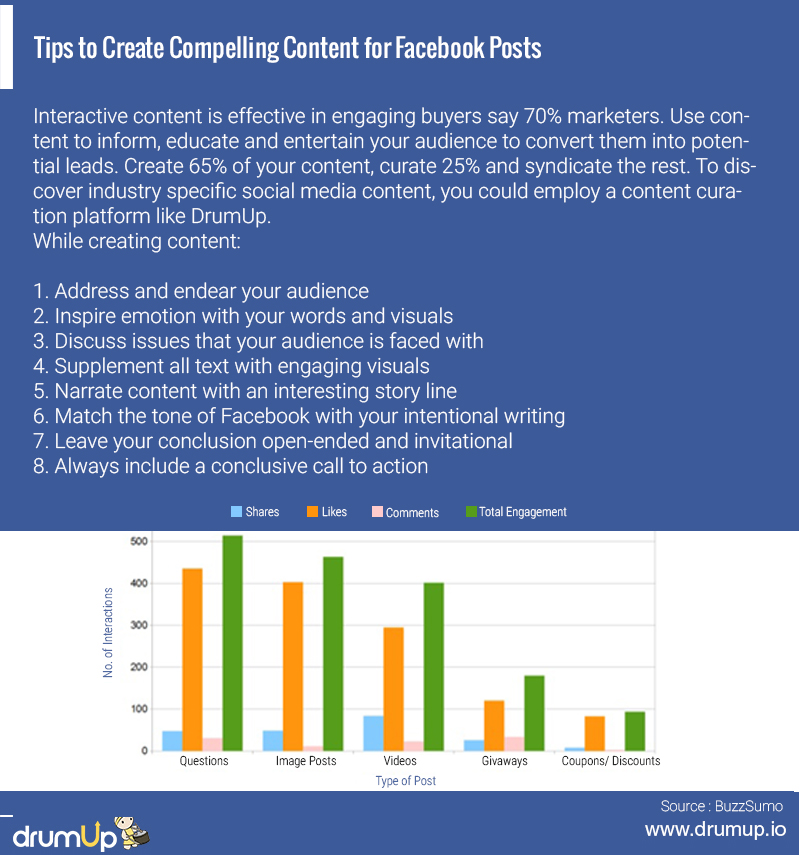
Before you begin creating content for Facebook, be sure to optimize your company page (text, display images, cover photos and the lot).
Interactive content is effective in engaging buyers say 70% marketers. Use content in engaging form to inform, educate and entertain your audience to convert them into potential leads.
The quality content conundrum
Unless you’re part machine, creating enough original and brilliant content to hold your engagement bar high on all social platforms is impossible. Not with all the other responsibilities social media managers have.
Fortunately, there exists a simple solution.
Your audience doesn’t care about who’s creating the content as long as it supplies them with actionable ideas that bring them results.
So curating content is okay! In fact as Neal Schaeffer and Pawan Deshpande have to say it is the most “Ridiculously easy way to maximize your social.”
But how much of your content should be curated (borrowed)? You can’t survive on a 100% of curated content if you’re hoping to establish a unique identity for your brand.
The general rule is to create 65%, curate another 25% and syndicate the rest. Curating can be just as much of a task as creating if you’re doing it manually. You could let DrumUp do the spade work and find you relevant social media content to share. But remember, you can’t simple share – organize, provide context and add a thought in the least in your post descriptions when sharing curated content.
While creating content
Creating stuff for social media isn’t easy; It has to be a 100% original, informative, engaging and different for each social platform. Just as all shoes don’t fit you, all types of content don’t flatter all social media sites. Each platform has its fun characteristics, usefulness and quirks. To befriend that platform and your audience, your content must get-along with the environment on it. For Facebook, it is essential for all of your brand’s communique to follow certain patterns and norms.
1. Address and endear your audience
Social media is built to connect people; Friends, families and businesses with their audiences.
The more distance you create with your writing, the less powerful you make social’s potential to help you connect.
Addressing your audience in your writing is important for 2 reasons:
a. It is likely to capture their attention and keep them interested
b. It takes the focus off your attempt to market and makes your content appear less-promotional
Always remind yourself that you’re writing for your audience, and social is never about you.
Imagine that you are at a farmer’s market, working to flag jam lovers to buy some jars of your homemade jam. Which of these banners do you think would buy you more attention?
a. “Deliciously nutty jam”
b. “Deliciously nutty jam packed specially for you”
When you add reference to your audience, it makes them feel cared for. Effectively what happens is, you call and they’ll come. Of course you’ll also require top-notch product to justify your claims, so your content (the blogs/brochures you’re sharing) should contain substance and ideas relevant to your audience that they don’t know of or are not using.
How to craft text on Facebook to involve your audience
1. Your company overview can be about you, but save the short and long descriptions for how your audience can benefit from your services
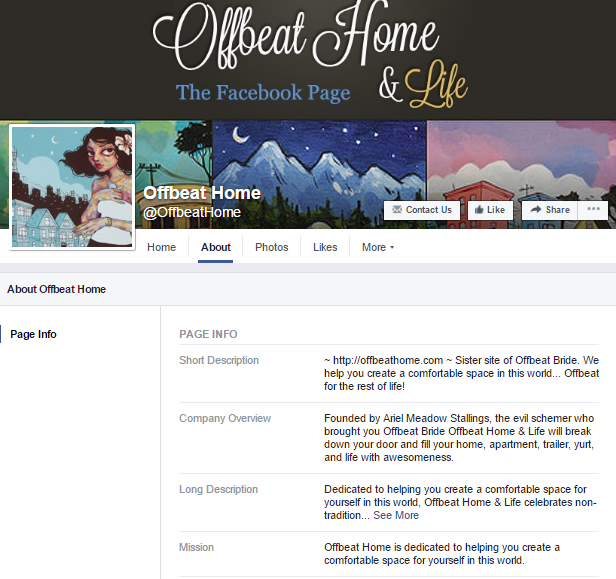
2. Craft the text for your Facebook posts with reference to your audience
3. Use event descriptions to tell your audience what is in it for them
2. Inspire emotion with your words and visuals
Of most social media platforms, Facebook has the most potential to incite emotion, with its unique engagement “emotions”, you even have direct means of gauging the effect you have on your audience.
Emotion is of the most powerful forms of marketing. Being able to connect with your audience on the deepest level allows for your brand to transcend the “commercial status” and move towards the “friend status”.
A huge part of most businesses is run on repeat orders and sustained relationships with customers. On social media, the sole way means of connecting with people is content – the content on your pages, posts and messages that you send.
Use it to excite, inspire and entertain your audience, communicate so they can relate to you and make best use of each post by designing it so your audience feels that you get them.
How to emotionally connect with your audience
1. Entertain with videos, gifs and comics related to your industry
2. Share specific, actionable and informative blogs
3. Extend the occasional informal festival wish or Monday morning wish
3. Discuss issues that your audience is faced with
The subject matter of your content is crucial; It makes or breaks how your audience reacts to it and decides the specificity of the audience that you attract to your Facebook page.
Share a lot of irrelevant content and your following will grow, but by diluting your content marketing results (Your customer acquisitions costs will increase and your conversion rates will decrease).
To pull the right audience to your page, you have to serve them precisely what they’re looking for, this is the truest way of making your content compelling (You could use Facebook’s targeted ads to attract high potential buyers, but you’d still need to post relevant content to keep that audience engaged). Write blogs and posts that are useful to your audience.
Match your audience interests to your topics that concern your industry and current trends, the intersection of the 3 will give you the hottest content for social media in general.
How to identify compelling content topics for blogs
1) List the top 10 interests of your audience and title blogs around them (Facebook’s audience insights give you demographics, lifestyle and purchase activity of your audience)
2) Use questions that you believe your audience is asking at the moment
3) Refer to what’s trending and create interesting topics around that (“Trending” can be customized to remove topics that don’t concern you – on personal profiles)
4. Supplement all text with engaging visuals
Visuals are indispensable on all social platforms. To get noticed among the 1500 odd stories on any given person’s feed, you require visuals. Kissmetrics has recorded 104% more comments, 84% more clicks and 53% more likes on posts with photographs.
Even the simplest of photographs can generate high engagement levels, given the right context and presentation.
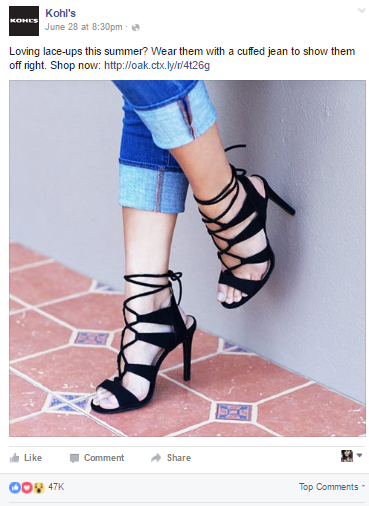
People love content that they can relate to. The idea matters more than complexity of a visual or the text.

Visuals bring with them options – You could do posters, memes, quote overlays, gifs, infographics, bit-strips and videos (created or curated).
How to populate your Facebook page with stunning visuals
1) Pair simple photographs with ideas that your audience can relate to
2) Share expert quotes or inspirational quotes on simple backgrounds
3) Create your own visuals to complement your content with easy to use tools
5. Narrate content with an interesting story line
Tell interesting and engaging stories with your content. Stories are memorable and fundamentally a part of human communication. They can be weaved into content to entertain, inform, enlighten and even influence an involved audience. Nudge your audience into the course of action you want them to take by making them arrive at it via a persuasive story (Don’t give them the answer, make them realize it).
Here’s the deal:
1) Don’t make your brand the star of the story, make your reader the protagonist instead so the story begins with him/her (And ends the same way)
2) Describe the issue/problem/obstacle
3) Make your products and services the support your reader requires to overcome the obstacle
4) Provide actionable and simple next steps (your Call To Action)
Several brands use amusing characters, mascots to endear their business to potential customers.
While writing your story, ensure that it is honest, has personality and leaves a little bit of suspense towards the end to get your reader to actually visit your website for me.
6. Match the tone of Facebook with your intentional writing
Some blogs prefer third person writing, a lot of others specifically request you to directly refer to your audience in writing.
On social media you should juggle the two as and when required. The ideal tone and style of writing to use is platform and situation specific.
Imagine you are on LinkedIn and you have to announce a news update related to your company. You wouldn’t do that in first person, you would stick to third person and adopt a formal tone.
Save time managing your social media accounts
Are you still managing your social media accounts directly from Facebook/Twitter/LinkedIn? Make your life easier by managing all your social media in one place, schedule posts, repeat posts, curate content and more. Try DrumUp now, it's free, forever.
Instead of a news update, suppose you have to share information and photographs of a company outing (Bonus tip: Social media loves behind the scenes), you would choose a more relaxed tone and use first or third person as needed.
On Facebook where the atmosphere is laid back you might lose out on connecting with your audience by posting like a news update.
So keep the tone light and friendly. Try and ask questions while introducing your blog posts. Converse with your audience. Make friends out of your fans. But do this without losing sight of your marketing goals on the platform (always add a clear and compelling CTA + back-links).
How to maintain a conversational tone on Facebook
1) Treat all of the content you upload as conversation initiators
2) Make an extra effort to start and participate in discussions with your fans
3) Add the occasional humorous and entertaining post that your audience might enjoy
4) The blogs you share should answer questions concerning your industry that trouble your audience
5) Conduct a cool contest once in a while to pump up some excitement
Finally, always leave your conclusions (at the end of your posts) open-ended and invitational. Ask people to participate, share with you their opinions and request them to share your content if they like it. Tag people when you can (don’t stalk people, only do this when you think it is called for and the tag-ee wouldn’t mind it).
Tips to drive fan engagement
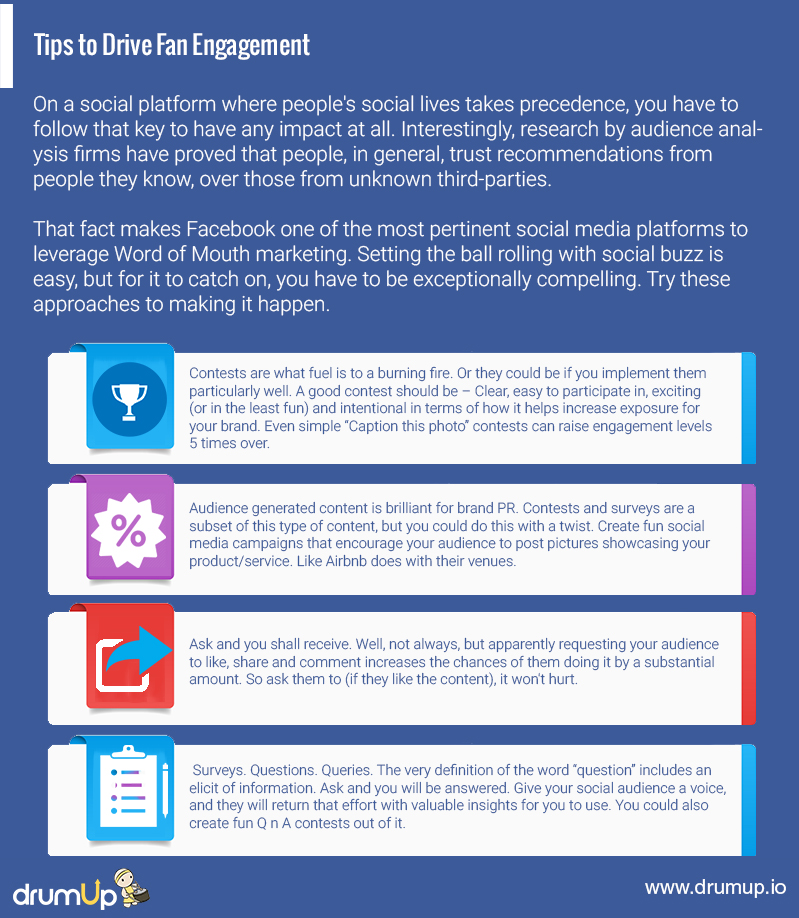
On a social platform where people’s social lives takes precedence, you have to follow that key to have any impact at all. Interestingly, research by audience analysis firms have proved that people, in general, trust recommendations from people they know, over those from unknown third-parties.
That fact makes Facebook one of the most pertinent social media platforms to leverage Word of Mouth marketing. Setting the ball rolling with social buzz is easy, but for it to catch on, you have to be exceptionally compelling. Try these approaches to making it happen.
1. Contests are what fuel is to a burning fire. Or they could be if you implement them particularly well. A good contest should be – Clear, easy to participate in, exciting (or in the least fun) and intentional in terms of how it helps increase exposure for your brand.
Even simple “Caption this photo” contests can raise engagement levels 5 times over.
2. Surveys. Questions. Queries. The very definition of the word “question” includes an elicit of information. Ask and you will be answered. Give your social audience a voice, and they will return that effort with valuable insights for you to use. You could also create fun Q n A contests out of it.
3. Audience generated content is brilliant for brand PR. Contests and surveys are a subset of this type of content, but you could do this with a twist. Create fun social media campaigns that encourage your audience to post pictures showcasing your product/service. Like Airbnb does with their venues.
4. Ask and you shall receive. Well, not always, but apparently requesting your audience to like, share and comment increases the chances of them doing it by a substantial amount. So ask them to (if they like the content), it won’t hurt.
Facebook Analytics
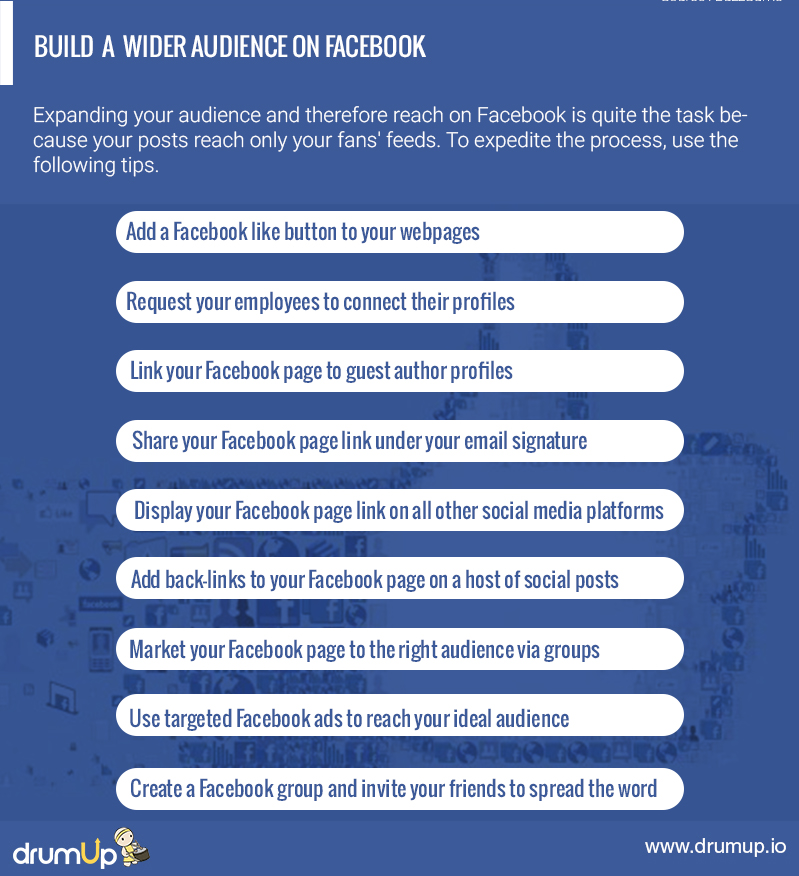
Understanding user interaction patterns helps you refine your Facebook content to drive better strategic decisions. Facebook has multiple, useful metrics.
Of the available features, you should monitor the following on a regular basis.
1. Page likes (organic, paid and net)
2. Page likes growth (over selected time intervals – a reflection of the strategies you have implemented during specific time periods)
3. Page visits (over selected time intervals)
4. Total reach (estimated exposure that your entire Facebook presence has)
5. Post reach (estimated exposure that a post has received)
6. Post engagement (per post – this reflects the success of the content on that post)
7. Engaged users (a reflection of your overall Facebook strategy)
8. Where your page likes came from (figure out where to focus your resources)
9. People talking about this (an estimate of your brand buzz)
10. When your fans are online (to identify the best time for you to post)
11. Demographics (insights on which audiences your content should be directed towards)
12. Benchmarking (a comparison of analytics between two different time intervals)
If you have Facebook marketing successes please feel free to discuss them in the comments section. Also, I’d love to hear your feedback on this post so I can improve how we assist you with content @drumupio.
Recommended reading:
1. The Ultimate Twitter Marketing Guide
2. The Ultimate LinkedIn Marketing Guide
Note: The entire infographic and its segments are available for reprint and sharing. Please feel free to do so with a link to this blog.
